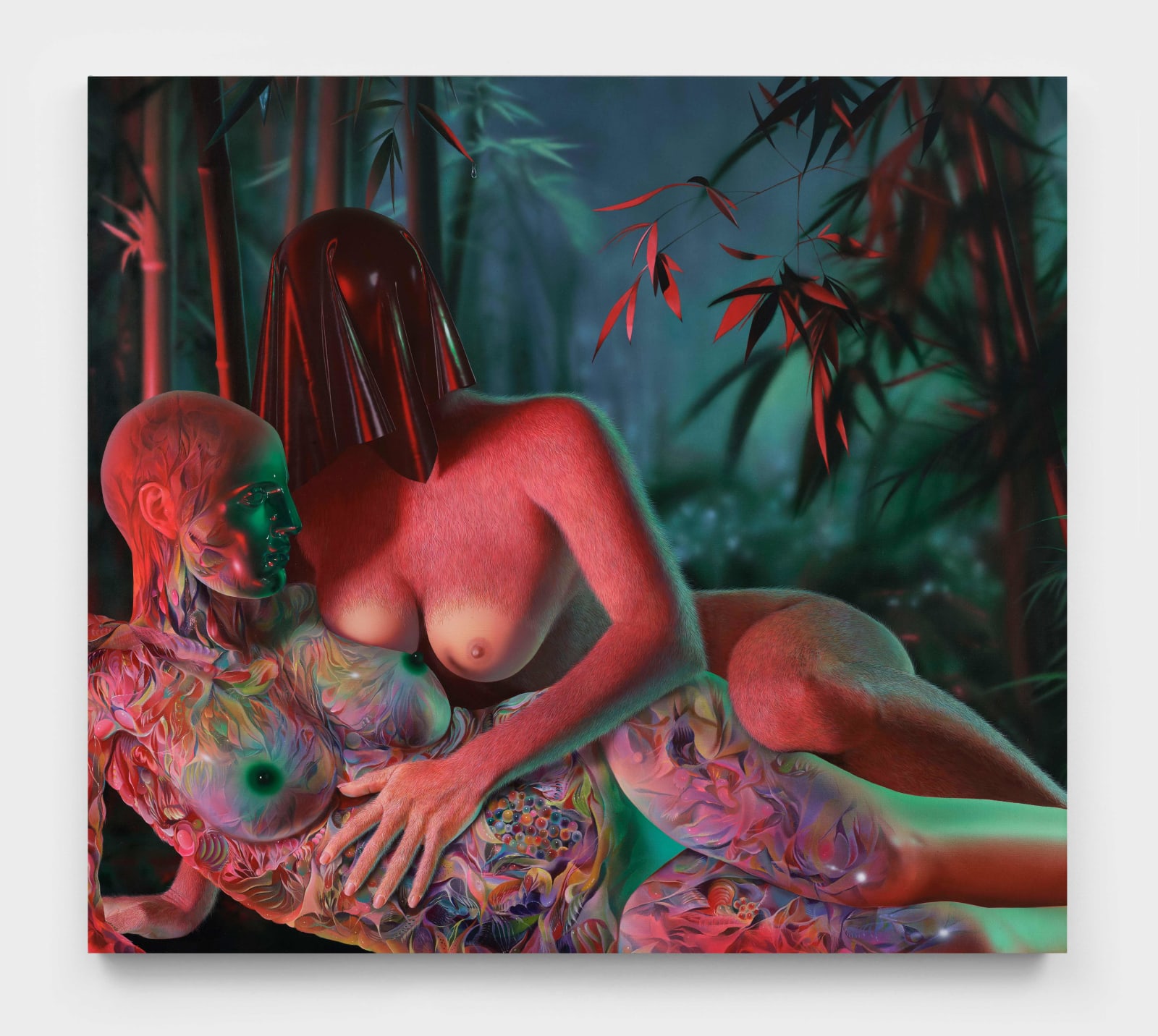Wang Haiyang 王海洋
Boundary 边界, 2024
acrylic on canvas 布面丙烯
80 x 90 cm
31 1/2 x 35 1/2 in
31 1/2 x 35 1/2 in
Wang Haiyang’s 'Boundary' (2024) presents a surreal and evocative scene that blurs the line between human identity and transformation. The painting depicts two figures set against the backdrop of a...
Wang Haiyang’s "Boundary" (2024) presents a surreal and evocative scene that blurs the line between human identity and transformation. The painting depicts two figures set against the backdrop of a mysterious forest, where the surroundings are both ambiguous and defined by sharp, detailed bamboo leaves. The use of contrast in the background emphasizes the surreal, dreamlike quality of the scene, inviting the viewer into an enigmatic, almost otherworldly space.
One figure embraces the other in an intimate yet unsettling manner. The first figure’s face is obscured by a dark fabric that seems almost like a silicone cover, lending her a sense of alienation and mystery. Her uncovered breasts are presented in a raw, exposed state, further accentuating the tension between concealment and vulnerability.
The second figure, in stark contrast, is portrayed in a state of transformation. Her body appears to pulse with organic, almost alien elements, as if in the midst of an evolutionary or metamorphic process. This figure seems caught between two states—human and something more primal, more organic—her form fluid and dynamic, emphasizing the transient and mutable nature of identity.
The embrace between the two figures suggests a complex relationship, one that transcends the physical, blurring boundaries between different forms of existence. The forest setting further amplifies this sense of mystery and transformation, positioning the figures within a natural world that is both familiar and strange. The painting invites viewers to reflect on the themes of change, identity, and the boundaries between self and other.
Wang Haiyang (b. 1984 in Shandong, China; currently lives and works between China and Italy) uses his sensitive perception of desire to depict the contradictory relationship between the "inner view" of the body and the "outer view" of the mundane world. His works are imbued with mysterious, futuristic tones, and retain a strong bond with Eastern philosophy. As Wang Haiyang himself said: "My work is a bow that is tightened, not an arrow that is released. What I want to describe is the uncalmable energy inside me, the surging force beneath the calm sea surface". In 2010, Wang Haiyang's first animation movie Freud, Fish and Butterfly won the Grand Prize at the Holland Animation Film Fest (HAFF). In 2012, Wang's film Double Fikret won the Silver Dove at the 55th DOK Leipzig Film Festival (Leipzig, Germany). In 2014, Wang won the Jury Nomination Award at the 3rd Huayu Youth Award in Sanya, China. His recent solo shows include Love Dart at Capsule Venice, Venice, Italy (2024), Wang Haiyang at Capsule Shanghai, Shanghai, China (2018)) and Wang Haiyang at White Space, Beijing, China (2018), By Himself at OCAT in Xi'an, China (2017); New Directions: Wang Haiyang at Ullens Center for Contemporary Art (UCCA) in Beijing, China (2016); Dynamic Field: Wang Haiyang at Minsheng Art Museum in Shanghai, China (2016).
《边界》(2024)中,王海洋模糊了人类身份和转变的边界,创造了一个超现实且引人遐想的空间。画面里,两位人物置身于一片神秘幽深的森林,周围朦胧模糊的景象由锐利细腻的竹叶剪影定义实体。背景中的强烈对比突显了梦境般的超现实氛围,仿佛引领观者步入一个陌生而奇异的异境。
其中一人轻拥着另一人,这一姿态既亲密又透着一丝不安。被拥抱者的面容隐没在一层深色的,宛如硅胶覆膜的织物之下,使她的存在更显神秘与疏离。而她裸露的双乳,则在一种毫无遮掩的坦呈中被展现,进一步放大了遮蔽与脆弱之间的张力。
相较之下,另一位人物则处于某种变形的临界点。她的身体上浮动蔓延着一种几乎像是异形元素的有机体。她宛若处于进化或蜕变的过程中,其形态介于人类与某种更原始、更自然的生命状态之间,流动而不定,反射出人类身份中那种转瞬即逝和易变的微妙本质。
两者之间的拥抱不仅是身体的交缠,更是指向一种复杂的,超越物理界限的关系,模糊了不同存在形式之间的边界。森林这一背景则进一步加深了神秘与变革的意象,使人物置身于一个既熟悉又异样的自然环境之中。整幅作品引导观者思考变迁、身份,以及自我与他者之间那道隐隐浮现又不断变换的边界。
王海洋(1984年生于山东,现工作生活于中国和意大利)用其敏感的欲望的感知力,描绘了"内观"身体与"外观"世界的矛盾关系,他的作品神秘、未来、带有强烈的东方哲学色彩。正如王海洋自己叙述:"我的作品就是一个拉紧的弓,并不是释放出的箭。我要描绘的就是那团在我身体里无法平复的东⻄,那层在平静海面之下暗涌的能量。"王海洋荣获诸多国际、国内艺术奖项。2010年王海洋凭第一部动画影片《弗洛伊德,鱼和蝴蝶》在荷兰国际动画节(HAFF)荣获首奖,2012年以《双面菲克雷特》在第55届莱比锡国际纪录片与动画电影节中获得银鸽奖,2014年获第三届华宇青年奖评委会提名奖。近期个展览包括"恋矢",胶囊威尼斯,意大利威尼斯(2024)和"王海洋",胶囊上海,中国上海(2018);"王海洋",空白空间,中国北京(2018);"王海洋:独自一人",OCAT西安馆,中国西安(2017);"新倾向:王海洋",尤伦斯当代艺术中心,中国北京(2016)以及"动力场:王海洋",上海民生当代美术馆,中国上海(2016)。
One figure embraces the other in an intimate yet unsettling manner. The first figure’s face is obscured by a dark fabric that seems almost like a silicone cover, lending her a sense of alienation and mystery. Her uncovered breasts are presented in a raw, exposed state, further accentuating the tension between concealment and vulnerability.
The second figure, in stark contrast, is portrayed in a state of transformation. Her body appears to pulse with organic, almost alien elements, as if in the midst of an evolutionary or metamorphic process. This figure seems caught between two states—human and something more primal, more organic—her form fluid and dynamic, emphasizing the transient and mutable nature of identity.
The embrace between the two figures suggests a complex relationship, one that transcends the physical, blurring boundaries between different forms of existence. The forest setting further amplifies this sense of mystery and transformation, positioning the figures within a natural world that is both familiar and strange. The painting invites viewers to reflect on the themes of change, identity, and the boundaries between self and other.
Wang Haiyang (b. 1984 in Shandong, China; currently lives and works between China and Italy) uses his sensitive perception of desire to depict the contradictory relationship between the "inner view" of the body and the "outer view" of the mundane world. His works are imbued with mysterious, futuristic tones, and retain a strong bond with Eastern philosophy. As Wang Haiyang himself said: "My work is a bow that is tightened, not an arrow that is released. What I want to describe is the uncalmable energy inside me, the surging force beneath the calm sea surface". In 2010, Wang Haiyang's first animation movie Freud, Fish and Butterfly won the Grand Prize at the Holland Animation Film Fest (HAFF). In 2012, Wang's film Double Fikret won the Silver Dove at the 55th DOK Leipzig Film Festival (Leipzig, Germany). In 2014, Wang won the Jury Nomination Award at the 3rd Huayu Youth Award in Sanya, China. His recent solo shows include Love Dart at Capsule Venice, Venice, Italy (2024), Wang Haiyang at Capsule Shanghai, Shanghai, China (2018)) and Wang Haiyang at White Space, Beijing, China (2018), By Himself at OCAT in Xi'an, China (2017); New Directions: Wang Haiyang at Ullens Center for Contemporary Art (UCCA) in Beijing, China (2016); Dynamic Field: Wang Haiyang at Minsheng Art Museum in Shanghai, China (2016).
《边界》(2024)中,王海洋模糊了人类身份和转变的边界,创造了一个超现实且引人遐想的空间。画面里,两位人物置身于一片神秘幽深的森林,周围朦胧模糊的景象由锐利细腻的竹叶剪影定义实体。背景中的强烈对比突显了梦境般的超现实氛围,仿佛引领观者步入一个陌生而奇异的异境。
其中一人轻拥着另一人,这一姿态既亲密又透着一丝不安。被拥抱者的面容隐没在一层深色的,宛如硅胶覆膜的织物之下,使她的存在更显神秘与疏离。而她裸露的双乳,则在一种毫无遮掩的坦呈中被展现,进一步放大了遮蔽与脆弱之间的张力。
相较之下,另一位人物则处于某种变形的临界点。她的身体上浮动蔓延着一种几乎像是异形元素的有机体。她宛若处于进化或蜕变的过程中,其形态介于人类与某种更原始、更自然的生命状态之间,流动而不定,反射出人类身份中那种转瞬即逝和易变的微妙本质。
两者之间的拥抱不仅是身体的交缠,更是指向一种复杂的,超越物理界限的关系,模糊了不同存在形式之间的边界。森林这一背景则进一步加深了神秘与变革的意象,使人物置身于一个既熟悉又异样的自然环境之中。整幅作品引导观者思考变迁、身份,以及自我与他者之间那道隐隐浮现又不断变换的边界。
王海洋(1984年生于山东,现工作生活于中国和意大利)用其敏感的欲望的感知力,描绘了"内观"身体与"外观"世界的矛盾关系,他的作品神秘、未来、带有强烈的东方哲学色彩。正如王海洋自己叙述:"我的作品就是一个拉紧的弓,并不是释放出的箭。我要描绘的就是那团在我身体里无法平复的东⻄,那层在平静海面之下暗涌的能量。"王海洋荣获诸多国际、国内艺术奖项。2010年王海洋凭第一部动画影片《弗洛伊德,鱼和蝴蝶》在荷兰国际动画节(HAFF)荣获首奖,2012年以《双面菲克雷特》在第55届莱比锡国际纪录片与动画电影节中获得银鸽奖,2014年获第三届华宇青年奖评委会提名奖。近期个展览包括"恋矢",胶囊威尼斯,意大利威尼斯(2024)和"王海洋",胶囊上海,中国上海(2018);"王海洋",空白空间,中国北京(2018);"王海洋:独自一人",OCAT西安馆,中国西安(2017);"新倾向:王海洋",尤伦斯当代艺术中心,中国北京(2016)以及"动力场:王海洋",上海民生当代美术馆,中国上海(2016)。



